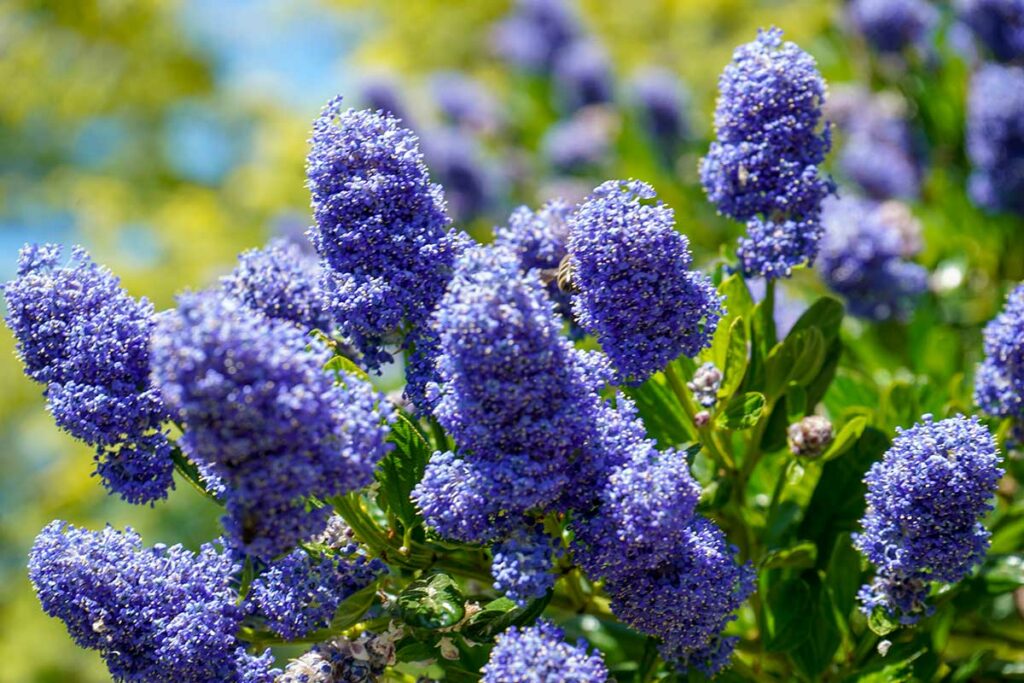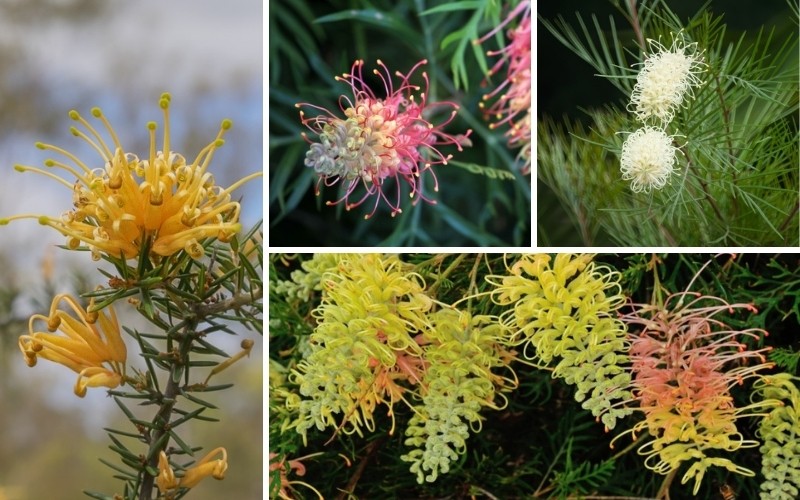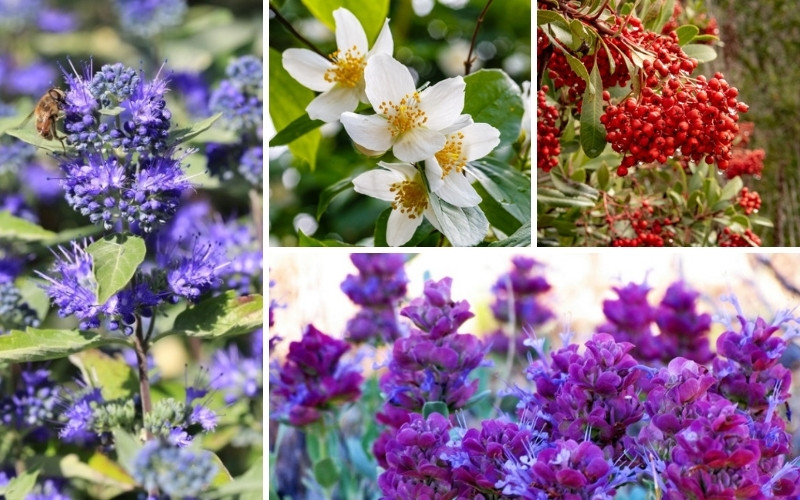
It can be challenging to choose the perfect shrubs for your property in Texas for various reasons. Home and landowners frequently add bushes in front or backyards to add height, texture, enhance security and enhance aesthetic appeal.
Texas has a particularly hot and dry climate, so learning more about how evergreen shrubs survive in Texas heat is essential when considering which shrubs to use for landscaping.
Reviewing this comprehensive list of the twelve best shrubs to plant in Texas will help homeowners choose which hedges to grow. From bushes that have flowers to those that are consistently green, with some study, finding the best option for your yard is easy.
Cenizo (Leucophyllum frutescens)

Cenizo, or Texas sage, is the best shrub to plant in a hot and dry climate. The shrub enjoys long hours in direct sunlight with little water, and homeowners can easily shear cenizo into a specific shape. Plant in a location with direct sun and avoid overwatering.
While the plant is one of the most drought-tolerant of any shrub, the shrub blooms with pink flowers when the weather is humid or after a rainstorm. Sometimes the shrub is called “barometer bush” because of the weather-dependent blooms.
Texas Mountain Laurel (Dermatophyllum secundiflorum)

Texas mountain laurel is a regional favorite, with purple flowers that bloom annually and often on Texas Independence Day. Texas mountain laurel is an evergreen that grows as a multi-trunked shrub or small tree. Plant Texas mountain laurel in dry, rocky, and well-drained soil for best results.
While often cultivated as a single tree, some homeowners sculpt it into a hedgerow. Growing laurel as a hedge is particularly common in older neighborhoods. Without gardening, the laurel will grow into a thicket of dark green vegetation.
Japanese Boxwood (Buxus microphylla)

Japanese Boxwood is a compact evergreen shrub that adds elegance to any home or garden since the plant is traditionally associated with formal gardens. The boxwood is short and grows to a maximum of five feet high.
So long as the Japanese Boxwood is planted in partial sun or appropriately shaded, it can survive the Texas heat and humidity. The shrub can live for years if watered well at least once a week during dry spells.
Yaupon Holly (Ilex vomitoria)

Yaupon holly is ubiquitous in residential and commercial landscapes across Texas. The shrub produces red berries that are associated with the winter holidays. Yaupon holly can be sheared, cut into creative topiaries, or trained up as an ornamental tree.
The plant is native to Texas, particularly the eastern side of the state. It can grow in clay but ideally grows best with more water access and soil with more rock for aeration. The holly is an evergreen that grows moderately fast. When planting, make sure the solid at the base stays well watered until the roots take hold.
Wax Myrtle (Myrica)

A wax myrtle usually grows along coastlines and thrives in sandy soils. It is fast-growing, so a wax myrtle can almost instantly create a hedge on your property. The wax myrtle is a native plant to North American, and its growth spans from New Jersey to Texas.
Both a standard and dwarf size, the wax myrtle is excellent for different types of landscaping needs. Plant wax myrtle in a position that receives full sun and in an area where its roots will be undisturbed by other plants or animals. The leaves of the shrub have a subtle but fragrant scent. Sometimes, the wax myrtle is known as a Bayberry or a Candleberry.
Agarita (Mahonia trifoliolata)

Agarita is a native plant in Texas; it is nearly drought-proof and also repels deer. Many landscapers and homeowners are adding agarita to their gardening plans. Specifically, many suburban homes aim to recreate a natural Hill Country vibe by adding evergreen sumac and mountain laurel alongside agarita.
Ashe Juniper (Juniperus ashei)

The Ashe Juniper, sometimes known as mountain cedar, grows naturally in the Texas Hill Country. While it is infamous for causing reactions for allergy sufferers, only the male plants release pollen, so homeowners can still enjoy an Ashe Juniper shrub without the allergic reaction. The female plants produce fruit, so not only will allergies be subsided, but also homeowners can pick blueberries!
Because the shrub is native, it is well adapted to withstand Texas’s hot, rocky conditions. Pruning is rarely required, and the juniper thrives in full sun.
Cherry Laurel (Prunus laurocerasus)

Cherry Laurel is a large evergreen shrub with dark glossy green leaves. It is fast-growing and forms dense shade. Cherry Laurel often grows naturally in damp, well-drained soils and is commonly found in southeast Texas.
As the Cherry Laurel ages, the bark darkens to near black. While the shrub does not endure in extremely hot or dry conditions, some parts of Texas are ideal for the plant. Indeed, San Antonio Botanical Garden has a beautiful display of cherry laurel.
Evergreen Sumac (Rhus virens)
Evergreen Sumac is a native plant that grows best in rocky soils. Evergreen sumac can grow to be six feet tall and produces edible berries that are quite tart.
The plant requires little care, and notably, most plants can be found and transplanted locally or from the wild. Many yards and pieces of property in Texas already have sumac growing.
Texas Sotol (Dasylirion texanum)

Texas Sotol is a medium shrub. It has light green leaves, a short trunk, and dramatic flower stalks that grow up to fifteen feet tall. Sotol flowers from May to August and attracts hummingbirds! Plant sotol in a full-sun location and do not water during the winter because the roots may rot if they are too damp.
Sotol is an effective hedge barrier because it grows sharp spines, so a sotol privacy fence offers multiple levels of protection. The plant needs well-drained and full sun to thrive. Many landscapers use Texas Sotol as a key accent in gardening designs.
Hannah Ray Bottlebrush (Callistemon viminalis)

There are various types of bottlebrush plants, and most bottlebrushes proliferate in a given area. The Hannah Ray bottlebrush is known for “weeping,” which creates a dramatic draping shape. Additionally, hummingbirds and butterflies love bottlebrushes and often pay visits to the plant.
Bottlebrushes are drought-tolerant once planted; the plant grows up to fifteen feet tall and grows large bright red flowers from spring to fall.
Prickly Pear (Opuntia)

Prickly Pear is easy to grow and is an excellent evergreen filler shrub in suburban landscaping. The plant is easily grown in every part of the state. The prickly pear is thicket-forming, and the prickly pear usually blooms in high summer. The plant ranges from three to nine feet tall and has a very high heat tolerance. Importantly, prickly pears need draining solid, so plant with a gravel mix.












